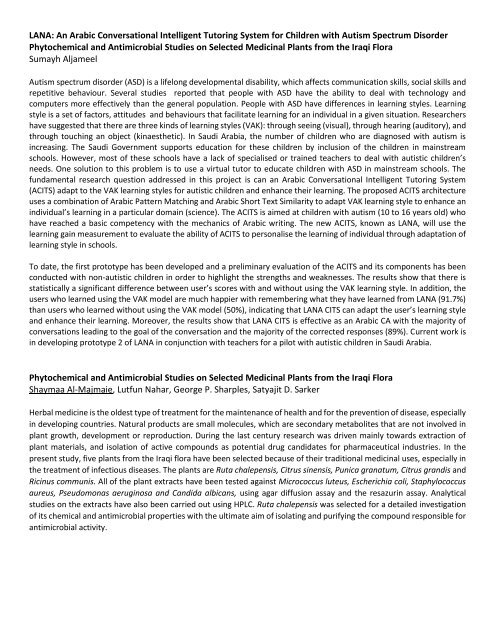Conference Programme FULL (1)
Create successful ePaper yourself
Turn your PDF publications into a flip-book with our unique Google optimized e-Paper software.
LANA: An Arabic Conversational Intelligent Tutoring System for Children with Autism Spectrum Disorder<br />
Phytochemical and Antimicrobial Studies on Selected Medicinal Plants from the Iraqi Flora<br />
Sumayh Aljameel<br />
Autism spectrum disorder (ASD) is a lifelong developmental disability, which affects communication skills, social skills and<br />
repetitive behaviour. Several studies reported that people with ASD have the ability to deal with technology and<br />
computers more effectively than the general population. People with ASD have differences in learning styles. Learning<br />
style is a set of factors, attitudes and behaviours that facilitate learning for an individual in a given situation. Researchers<br />
have suggested that there are three kinds of learning styles (VAK): through seeing (visual), through hearing (auditory), and<br />
through touching an object (kinaesthetic). In Saudi Arabia, the number of children who are diagnosed with autism is<br />
increasing. The Saudi Government supports education for these children by inclusion of the children in mainstream<br />
schools. However, most of these schools have a lack of specialised or trained teachers to deal with autistic children’s<br />
needs. One solution to this problem is to use a virtual tutor to educate children with ASD in mainstream schools. The<br />
fundamental research question addressed in this project is can an Arabic Conversational Intelligent Tutoring System<br />
(ACITS) adapt to the VAK learning styles for autistic children and enhance their learning. The proposed ACITS architecture<br />
uses a combination of Arabic Pattern Matching and Arabic Short Text Similarity to adapt VAK learning style to enhance an<br />
individual’s learning in a particular domain (science). The ACITS is aimed at children with autism (10 to 16 years old) who<br />
have reached a basic competency with the mechanics of Arabic writing. The new ACITS, known as LANA, will use the<br />
learning gain measurement to evaluate the ability of ACITS to personalise the learning of individual through adaptation of<br />
learning style in schools.<br />
To date, the first prototype has been developed and a preliminary evaluation of the ACITS and its components has been<br />
conducted with non-autistic children in order to highlight the strengths and weaknesses. The results show that there is<br />
statistically a significant difference between user’s scores with and without using the VAK learning style. In addition, the<br />
users who learned using the VAK model are much happier with remembering what they have learned from LANA (91.7%)<br />
than users who learned without using the VAK model (50%), indicating that LANA CITS can adapt the user’s learning style<br />
and enhance their learning. Moreover, the results show that LANA CITS is effective as an Arabic CA with the majority of<br />
conversations leading to the goal of the conversation and the majority of the corrected responses (89%). Current work is<br />
in developing prototype 2 of LANA in conjunction with teachers for a pilot with autistic children in Saudi Arabia.<br />
Phytochemical and Antimicrobial Studies on Selected Medicinal Plants from the Iraqi Flora<br />
Shaymaa Al-Majmaie, Lutfun Nahar, George P. Sharples, Satyajit D. Sarker<br />
Herbal medicine is the oldest type of treatment for the maintenance of health and for the prevention of disease, especially<br />
in developing countries. Natural products are small molecules, which are secondary metabolites that are not involved in<br />
plant growth, development or reproduction. During the last century research was driven mainly towards extraction of<br />
plant materials, and isolation of active compounds as potential drug candidates for pharmaceutical industries. In the<br />
present study, five plants from the Iraqi flora have been selected because of their traditional medicinal uses, especially in<br />
the treatment of infectious diseases. The plants are Ruta chalepensis, Citrus sinensis, Punica granatum, Citrus grandis and<br />
Ricinus communis. All of the plant extracts have been tested against Micrococcus luteus, Escherichia coli, Staphylococcus<br />
aureus, Pseudomonas aeruginosa and Candida albicans, using agar diffusion assay and the resazurin assay. Analytical<br />
studies on the extracts have also been carried out using HPLC. Ruta chalepensis was selected for a detailed investigation<br />
of its chemical and antimicrobial properties with the ultimate aim of isolating and purifying the compound responsible for<br />
antimicrobial activity.


